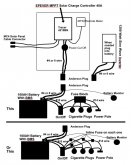Here is my diagram for my battery box.
Place take a look and see if I have anything wrong or need to change anything or add anything to it.
Solar charge controller will not be in the box it will be mounted on wood.
The inverter will not be in the box but ready to be plugged in when needed.
I wanted to set it up like this so when I make a second battery box I can use the same Solar charge controller and just swop out the boxes plug and play.
I have two 200 watt solar panels I will mount on our shed roof.
The battery will be a SOK Battery 100Ah 12V LiFePO4 Lithium Iron Phosphate.
I Have two different versions of wiring it up but not sure if I have it right or not? Or what version would be best to have an On/Off box switch?
Fuse block VS inline fuse?
Thanks

Place take a look and see if I have anything wrong or need to change anything or add anything to it.
Solar charge controller will not be in the box it will be mounted on wood.
The inverter will not be in the box but ready to be plugged in when needed.
I wanted to set it up like this so when I make a second battery box I can use the same Solar charge controller and just swop out the boxes plug and play.
I have two 200 watt solar panels I will mount on our shed roof.
The battery will be a SOK Battery 100Ah 12V LiFePO4 Lithium Iron Phosphate.
I Have two different versions of wiring it up but not sure if I have it right or not? Or what version would be best to have an On/Off box switch?
Fuse block VS inline fuse?
Thanks



